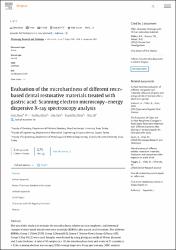Evaluation of the microhardness of different resin-based dental restorative materials treated with gastric acid: Scanning electron microscopy–energy dispersive X-ray spectroscopy analysis
Citation
Microscopy Research and TechniqueVolume 84, Issue 9, Pages 2140 - 2148September 2021 Document type Article Source type Journal ISSN 1059910X DOI 10.1002/jemt.23769 View more Evaluation of the microhardness of different resin-based dental restorative materials treated with gastric acid: Scanning electron microscopy–energy dispersive X-ray spectroscopy analysis Ünal, MurataSend mail to Ünal M.;Candan, Mervea;İpek, İrema;Küçükoflaz, Merveb;Özer, Alic Save all to author list a Faculty of Dentistry, Department of Pediatric Dentistry, Sivas Cumhuriyet University, Sivas, Turkey b Faculty of Engineering, Department of Biomedical Engineering, Erciyes University, Kayseri, Turkey c Faculty of Engineering, Department of Metallurgy and Material Engineering, Sivas Cumhuriyet University, Sivas, Turkey 169th percentile Citation in Scopus 0,75 FWCI FWCI View all metrics Evaluation of the microhardness of different resin-based dental restorative materials treated with gastric acid: Scanning electron microscopy–energy dispersive X-ray spectroscopy analysis Full text options Export Abstract Author keywords Reaxys Chemistry database information Indexed keywords SciVal Topics Chemicals and CAS Registry Numbers Metrics Abstract The aim of this study is to evaluate the microhardness, relative surface roughness, and elemental changes of resin-based dental restorative materials (RDRMs) after gastric acid treatment. Five different RDRMs (Group 1 [Filtek Z550], Group 2 [Beautifil II], Group 3 [Vertise Flow], Group 4 [Dyract XP], Group 5 [Fuji II LC]) were used. Samples were formed by using plexiglass molds of 10 mm diameter and 2 mm thickness. A total of 50 samples (n = 10) for microhardness tests and a total of 15 samples (n = 3) for scanning electron microscopy (SEM)–energy dispersive X-ray spectroscopy (EDX) analysis were prepared. All samples of each group were treated to gastric acid, simultaneously. A Vickers microhardness tester was used to evaluate the microhardness of the upper surfaces of each sample. SEM–EDX system was used for microstructure and elemental composition detection. The SEM–EDX, microhardness and relative surface roughness analysis were made prior to treatment in gastric acid for 14 days and analysis were repeated on the 14th day. As the difference in the microhardness values of RDRMs was compared, the time-dependent variation in all RDRMs was found to be statistically significant. It was observed that a drastic decrease in microhardness values was in Beautifil II, Filtek Z550, Vertise Flow, Fuji II LC, and Dyract XP, respectively. Average decrease rate of microhardness values compared to the initial state can be listed from high to low as Beautifil II (%35.72), Vertise Flow (% 28.88), Fuji II LC (% 21.09), Dyract XP (%17.60), and Filtek Z550 (% 16.58). As a result, in in-vitro conditions gastric acid decreased microhardness while increasing the relative surface roughness of RDRMs. © 2021 Wiley Periodicals LLC. Author keywords gastric acid; microhardness; relative surface roughness; SEM–EDXAbstract
The aim of this study is to evaluate the microhardness, relative surface roughness, and elemental changes of resin-based dental restorative materials (RDRMs) after gastric acid treatment. Five different RDRMs (Group 1 [Filtek Z550], Group 2 [Beautifil II], Group 3 [Vertise Flow], Group 4 [Dyract XP], Group 5 [Fuji II LC]) were used. Samples were formed by using plexiglass molds of 10 mm diameter and 2 mm thickness. A total of 50 samples (n = 10) for microhardness tests and a total of 15 samples (n = 3) for scanning electron microscopy (SEM)–energy dispersive X-ray spectroscopy (EDX) analysis were prepared. All samples of each group were treated to gastric acid, simultaneously. A Vickers microhardness tester was used to evaluate the microhardness of the upper surfaces of each sample. SEM–EDX system was used for microstructure and elemental composition detection. The SEM–EDX, microhardness and relative surface roughness analysis were made prior to treatment in gastric acid for 14 days and analysis were repeated on the 14th day. As the difference in the microhardness values of RDRMs was compared, the time-dependent variation in all RDRMs was found to be statistically significant. It was observed that a drastic decrease in microhardness values was in Beautifil II, Filtek Z550, Vertise Flow, Fuji II LC, and Dyract XP, respectively. Average decrease rate of microhardness values compared to the initial state can be listed from high to low as Beautifil II (%35.72), Vertise Flow (% 28.88), Fuji II LC (% 21.09), Dyract XP (%17.60), and Filtek Z550 (% 16.58). As a result, in in-vitro conditions gastric acid decreased microhardness while increasing the relative surface roughness of RDRMs.
Source
Microscopy Research and TechniqueVolume
9Issue
84URI
https://www.scopus.com/record/display.uri?eid=2-s2.0-85104413923&origin=resultslist&sort=plf-f&featureToggles=FEATURE_NEW_DOC_DETAILS_EXPORT:1https://hdl.handle.net/20.500.12418/12943















